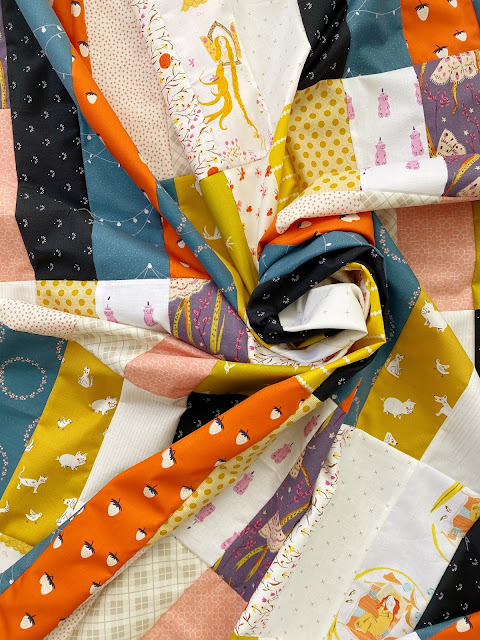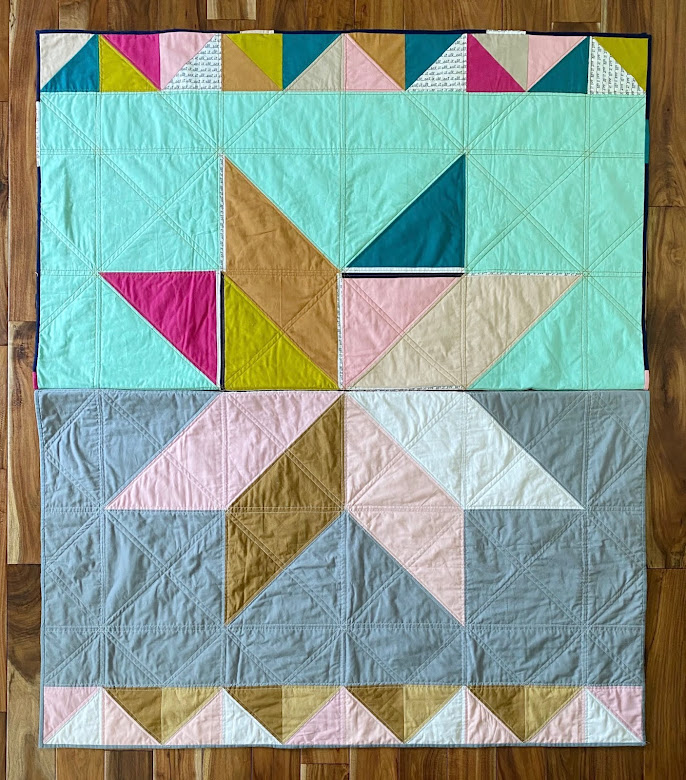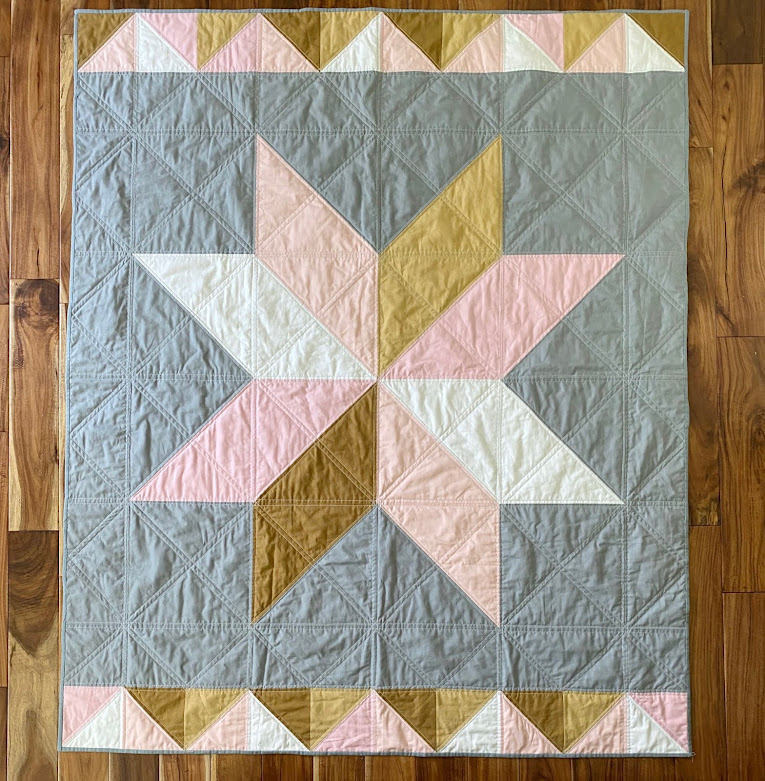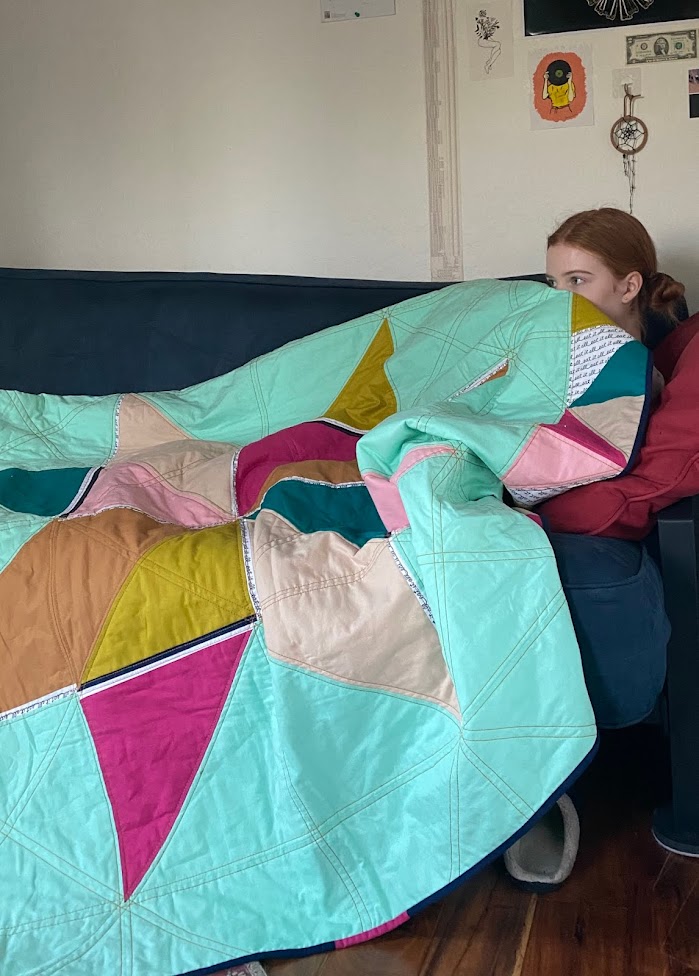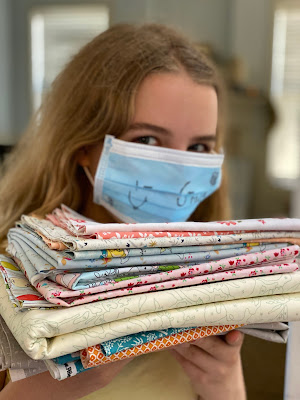the above image was recently posted to IG, and got
reposted by a nice little liberty fabric shop called
ava and neve. ever since then, i have been getting requests for a pattern, which makes me giggle a bit because there isn't one. this is another of my scrap projects begotten by a project. also, maybe i'm missing out on a pattern writing opportunity here, but that's okay. i'm a hobby quilter with no time for making a business out of this stuff. i will describe my process here for anyone interested in making something similar.
this is a horrible winter afternoon shot of the quilt top, now pinbasted and ready for handquilting. when I have a better one, i'll replace this, but I wanted a full frontal shot of the complete top so interested quilters could see what it looks like.
when i was cutting strips for my
betsy scrappy trip quilt, i made quite a few scraps. as usual, i just started cutting without paying attention to amounts i was producing. one
wof strip of liberty tana lawn went a lot further than i needed for that original quilt. in some cases, before i realized this, i cut two! also, when i was cutting the chambray fabric, after cutting the correct sizes for the scrappy trip quilt, i was left with pieces 11.5" long from each strip. that's where the size of these longer rows comes from.
this quilt simply evolved from those cuttings.
therefore, i don't have exact measurements for this "pattern." however, it's so very easy that any quilter with a little experience can follow along. if you're one of those people who needs all the details spelled out, i'm so sorry. please remember this is free! and i gave up my quilting time yesterday and today to write this out.
fabric and cutting
this quilt is composed of two kinds of fabric:
- moda cross weave in "chambray"
-liberty of london tana lawn (here, all betsy in various colorways i have collected over the years)
all pieces are cut at 2.5" wide.
chambray
so how much do you need? the chambray is easier to estimate since we can just add the numbers up. assuming 42"
wof, you can get 3 - 11.5" pieces out of each 2.5" x
wof strip cut, with leftovers. the layout requires 12 chambray strips per row, so you need 60 - 2.5" x 11.5". you will also need 24 - 2.5" x 2.5" squares, which can be taken out of the leftover pieces from the strips.
or you could cut the first 24
wof x 2.5" strip into 2 pieces at 14" long, and 1 piece at 11.5" long. then, after you have attached the liberty pieces to the chambray, you could cut off the 2.5" and already have your squares made and assembled, too.
or if you don't like the scrap created/waste of the 7.5" at the end, you could cut 4 - 10.5" strips and add some extra rows of squares in the top to make up the few lost inches in length. you will also need to cut 2 more
wof strips to make the 2.5" squares.
all of these chambray strips can be gotten out of approximately 1.5 yards of chambray.
betsy
my betsy pieces were almost all from scrap. i have approximately 20 different colors of betsy that i used for this quilt. some were cut from fat quarters and others were cut from full
wof strips (which for liberty tana lawn is more like 56", i think).
 |
| strips i still have left after this second quilt |
i would recommend that you cut one
wof strip from each betsy you have, see how many strips you get, and then cut more as needed.
how many different betsys you are cutting from will determine how much of each you will need. this is an adventure in betsys! there's no real telling where you are going or where you will end up. i hope you like adventurous, ambiguous quilt top making, because that's what this is. personally, i had a lot of fun with this part of the process.
here's a little bit of quilt math to get you started: one 2.5" x
wof of liberty strip should give you at least 4 - 11.5" strips. to my recollection,
width of fabric on liberty tana lawn is about 56".
you can use just one betsy per strip piece, or you can put two or more together like i did. i'll share more about that below in the layout section.
at bare minimum, you will be using 1.5yd of betsy just like the chambray.
quilt layout
this quilt measures 48" wide x 62.5" long.
these measurements can be adjusted by either lengthening strips or adding more rows to the length, or widened by simply adding more pairs of liberty + chambray to the width of the rows. you'll need to do that math yourself, but it's pretty easy to do.
there are 5 rows of strips that are 2.5" wide x 11.5" long, and two rows that are 2.5" x 2.5" squares.
the layout is: 1 row of strips, 1 row of squares, 3 rows of strips, 1 row of squares, 1 row of strips.
if you look at the full quilt top shot above, you should be able to see this.
if we called the top row A, the pattern looks like this:
row A: 24 strips 11.5" long, start with betsy
row B: 24 2.5" squares, start with chambray
row C: 24 strips 11.5" long, start with betsy
row D: 24 strips 11.5" long, start with chambray
row E: 24 strips 11.5" long, start with betsy
row F: 24 2.5" squares, start with chambray
row G: 24 strips 11.5" long, start with betsy
the quilt is composed of pairs of 1 chambray strip to 1 betsy strip, 12 pairs per row. in order to get them to alternate from row to row, simply start each row with whichever type of fabric you didn't start with in the previous row. i indicated that in the above layout description.
when you pair the fabrics, you can use a full strip of betsy per chambray piece, or you can combine different betsys. i just did this at random.
if i had a betsy piece that was shorter than the chambray strip, i selected another betsy and sewed them together to make up the difference. i cut the excess after i sewed the pieces together.
in some cases, i took a bit off of both pieces just to help vary the different lengths. this also gave me another small scrap to work with for another strip.
i didn't want all the pieces to have just 2 betsys, so i did some with 3 or even 4 small scraps.
here's two options for using the small piece and more strips:
to make the squares, i first cut the chambray squares from the chambray scraps and then sewed them to betsy strips. it felt easier to handle that way than 2 small squares, but that's just me.
i love a good chain pieced bunting!
i added the two rows of 2.5" squares to the quilt to increase the length a little. i didn't want it to be 55" long or 66" long, either, which is what rows of just 11.5" strips would have given me. also, i like the way it breaks up the quilt a bit and it nods to the quilt this evolved from - the scrappy trip quilt that is all 2.5" squares.
my seam matching on these rows was not that precise in a lot of places. i tried, but it's true that tana lawn is a little slippery. and pressing can stretch your fabrics when you have a heavy hand, like it do. i put as much care and effort into precision as i want to and live with the results.
other people have great success with pinning (my results are the same regardless, go figure) and starching the liberty.
a few other notes
i did not prewash either fabric. i've made quilts from this combination before and had no problems when washed after completion.
all seams were sewn at 1/4" seam allowance. the measurements so far have all been for cut fabric. of course, when the seams are all sewn, .5" needs to be removed from the cut measurement to know the sewn/final measurement.
because of the lightness of the tana lawn, i chose to always press toward the chambray, except between rows, of course, where that wasn't possible.
i now have the quilt pin basted and ready for handquilting. when that' done, i'll share the complete quilt.
if you're going to make this quilt or one like it, enjoy!
thanks for stopping by and for the interest.
*
wof means
width of fabric, the distance from selvage to selvage across your fabric.











